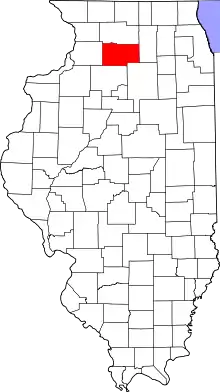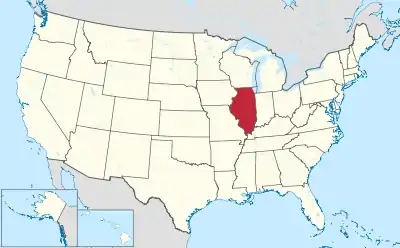Lee County, Illinois
Lee County is a county located in the U.S. state of Illinois. According to the 2010 census, it has a population of 36,031.[1] Its county seat is Dixon.[2]
Lee County | |
|---|---|
 Lee County Courthouse | |
 Location within the U.S. state of Illinois | |
 Illinois's location within the U.S. | |
| Coordinates: 41°45′N 89°18′W | |
| Country | |
| State | |
| Founded | February 27, 1839 |
| Named for | Henry Lee III |
| Seat | Dixon |
| Largest city | Dixon |
| Area | |
| • Total | 729 sq mi (1,890 km2) |
| • Land | 725 sq mi (1,880 km2) |
| • Water | 4.1 sq mi (11 km2) 0.6% |
| Population (2010) | |
| • Total | 36,031 |
| • Estimate (2018) | 34,223 |
| • Density | 49/sq mi (19/km2) |
| Time zone | UTC−6 (Central) |
| • Summer (DST) | UTC−5 (CDT) |
| Congressional district | 16th |
| Website | www |
The Dixon, IL Micropolitan Statistical Area includes all of Lee County.
History
The area's first non-native settlers were mostly from the six New England states.[3] The early nineteenth century saw a wave of westward movement from New England, due largely to completion of the Erie Canal and the end of the Black Hawk War.[4][5]
The area that included present-day Lee County was delineated as St. Clair County in 1809. In 1823, a large section of northern St. Clair County was partitioned off as Fulton County. In 1825, the northwestern portion of that county was partitioned off as Putnam County. In 1831, the area was further partitioned into Jo Daviess County. A section of that county was partitioned off in 1836 as Ogle County, and in 1839 the bottom half of Ogle County was split off as Lee County. It is largely understood that the county's name honors "Lighthorse Harry" Lee, an officer in the American Revolutionary War.[6] An alternative theory suggests the name honors Richard Henry Lee, a member of the Continental Congress (the Declaration of Independence was adopted pursuant to the Lee Resolution).
President Ronald Reagan lived in Dixon as a boy and attended Dixon High School.[7]
 Lee County's boundaries have remained unchanged since its creation in 1839.
Lee County's boundaries have remained unchanged since its creation in 1839.
Geography
According to the US Census Bureau, the county has a total area of 729 square miles (1,890 km2), of which 725 square miles (1,880 km2) is land and 4.1 square miles (11 km2) (0.6%) is water.[8]
Adjacent counties
- Ogle County – north
- DeKalb County – east
- LaSalle County - southeast, south
- Bureau County – south, southwest
- Whiteside County – west
Climate and weather
| Dixon, Illinois | ||||||||||||||||||||||||||||||||||||||||||||||||||||||||||||
|---|---|---|---|---|---|---|---|---|---|---|---|---|---|---|---|---|---|---|---|---|---|---|---|---|---|---|---|---|---|---|---|---|---|---|---|---|---|---|---|---|---|---|---|---|---|---|---|---|---|---|---|---|---|---|---|---|---|---|---|---|
| Climate chart (explanation) | ||||||||||||||||||||||||||||||||||||||||||||||||||||||||||||
| ||||||||||||||||||||||||||||||||||||||||||||||||||||||||||||
| ||||||||||||||||||||||||||||||||||||||||||||||||||||||||||||
In recent years, average temperatures in the county seat of Dixon have ranged from a low of 10 °F (−12 °C) in January to a high of 82 °F (28 °C) in July, although a record low of −27 °F (−33 °C) was recorded in January 1999 and a record high of 110 °F (43 °C) was recorded in July 1936. Average monthly precipitation ranges from 1.43 inches (36 mm) in February to 4.88 inches (124 mm) in June.[9]
Major highways
Other features
Demographics
| Historical population | |||
|---|---|---|---|
| Census | Pop. | %± | |
| 1840 | 2,035 | — | |
| 1850 | 5,292 | 160.0% | |
| 1860 | 17,651 | 233.5% | |
| 1870 | 27,171 | 53.9% | |
| 1880 | 27,491 | 1.2% | |
| 1890 | 26,187 | −4.7% | |
| 1900 | 29,894 | 14.2% | |
| 1910 | 27,750 | −7.2% | |
| 1920 | 28,004 | 0.9% | |
| 1930 | 32,329 | 15.4% | |
| 1940 | 34,604 | 7.0% | |
| 1950 | 36,451 | 5.3% | |
| 1960 | 38,749 | 6.3% | |
| 1970 | 37,947 | −2.1% | |
| 1980 | 36,328 | −4.3% | |
| 1990 | 34,392 | −5.3% | |
| 2000 | 36,062 | 4.9% | |
| 2010 | 36,031 | −0.1% | |
| 2018 (est.) | 34,223 | [10] | −5.0% |
| US Decennial Census[11] 1790-1960[12] 1900-1990[13] 1990-2000[14] 2010-2013[1] | |||
As of the 2010 United States Census, there were 36,031 people, 13,758 households, and 9,064 families residing in the county.[15] The population density was 49.7 inhabitants per square mile (19.2/km2). There were 15,049 housing units at an average density of 20.8 per square mile (8.0/km2).[8] The racial makeup of the county was 90.9% white, 4.8% black or African American, 0.7% Asian, 0.2% American Indian, 1.9% from other races, and 1.5% from two or more races. Those of Hispanic or Latino origin made up 5.0% of the population.[15] In terms of ancestry, 38.0% were German, 18.8% were Irish, 8.4% were English, and 8.2% were American.[16]
Of the 13,758 households, 30.0% had children under the age of 18 living with them, 51.2% were married couples living together, 10.0% had a female householder with no husband present, 34.1% were non-families, and 28.8% of all households were made up of individuals. The average household size was 2.41 and the average family size was 2.94. The median age was 42.0 years.[15]
The median income for a household in the county was $48,502 and the median income for a family was $60,759. Males had a median income of $42,114 versus $30,920 for females. The per capita income for the county was $24,440. About 7.6% of families and 9.6% of the population were below the poverty line, including 11.8% of those under age 18 and 6.5% of those age 65 or over.[17]
Communities

Unincorporated communities
Politics
Lee County is, together with neighboring Ogle County, the most consistently Republican county in Illinois. It is one of very few counties in the United States to have never supported a Democrat for President since the Civil War.
Since the election of 1860 the Republican party candidate for president has won Lee County, Illinois with only one exception, that being in 1912 when Theodore Roosevelt won the county while running as a member of the Progressive Party, unofficially known as the "Bull Moose" party.
| Year | Republican | Democratic | Third parties |
|---|---|---|---|
| 2020 | 58.6% 9,630 | 39.0% 6,407 | 2.4% 403 |
| 2016 | 55.6% 8,612 | 35.7% 5,528 | 8.7% 1,349 |
| 2012 | 52.5% 8,059 | 45.2% 6,937 | 2.3% 352 |
| 2008 | 50.5% 8,258 | 47.5% 7,765 | 2.0% 334 |
| 2004 | 58.6% 9,307 | 40.4% 6,416 | 1.0% 153 |
| 2000 | 55.2% 8,069 | 41.8% 6,111 | 3.0% 440 |
| 1996 | 47.1% 6,677 | 41.6% 5,895 | 11.4% 1,610 |
| 1992 | 43.2% 6,652 | 35.9% 5,530 | 21.0% 3,235 |
| 1988 | 65.5% 8,903 | 33.9% 4,608 | 0.6% 85 |
| 1984 | 73.8% 11,178 | 25.9% 3,919 | 0.4% 58 |
| 1980 | 73.7% 11,373 | 20.5% 3,170 | 5.8% 895 |
| 1976 | 57.5% 8,674 | 40.3% 6,076 | 2.2% 326 |
| 1972 | 68.7% 10,636 | 30.9% 4,788 | 0.4% 65 |
| 1968 | 62.9% 9,598 | 31.0% 4,727 | 6.1% 930 |
| 1964 | 53.6% 8,445 | 46.4% 7,315 | |
| 1960 | 64.7% 10,835 | 35.2% 5,896 | 0.1% 8 |
| 1956 | 72.0% 11,653 | 28.0% 4,531 | 0.0% 5 |
| 1952 | 71.7% 11,941 | 28.2% 4,700 | 0.1% 10 |
| 1948 | 67.0% 9,001 | 32.5% 4,368 | 0.5% 72 |
| 1944 | 67.9% 10,397 | 32.0% 4,899 | 0.1% 21 |
| 1940 | 65.0% 11,228 | 34.7% 6,005 | 0.3% 52 |
| 1936 | 54.9% 8,914 | 42.2% 6,845 | 2.9% 473 |
| 1932 | 51.5% 7,802 | 47.4% 7,182 | 1.2% 177 |
| 1928 | 67.1% 9,238 | 32.5% 4,476 | 0.3% 46 |
| 1924 | 69.4% 8,363 | 19.6% 2,367 | 11.0% 1,327 |
| 1920 | 78.9% 7,615 | 17.8% 1,715 | 3.3% 316 |
| 1916 | 64.0% 7,985 | 32.7% 4,087 | 3.3% 414 |
| 1912 | 23.0% 1,482 | 31.0% 1,995 | 46.0% 2,959 |
| 1908 | 63.5% 4,255 | 32.0% 2,144 | 4.5% 302 |
| 1904 | 69.8% 4,634 | 24.2% 1,604 | 6.1% 404 |
| 1900 | 63.6% 4,820 | 33.3% 2,528 | 3.1% 237 |
| 1896 | 64.8% 4,797 | 33.3% 2,469 | 1.9% 139 |
| 1892 | 54.2% 3,513 | 42.3% 2,740 | 3.5% 224 |
As of 2018, Lee County is in the 16th congressional district, the 45th legislative district, and the 74th and 90 representative districts.[20]
Notes
References
- "State & County QuickFacts". US Census Bureau. Archived from the original on June 23, 2011. Retrieved July 6, 2014.
- "Find a County". National Association of Counties. Retrieved June 7, 2011.
- Stevens, Frank Everett. History of Lee County, Illinois, Vol. 1 p. 382
- Holbrook, Stewart Hall. The Yankee Exodus: An Account of Migration from New England, University of Washington Press (1968)
- Shalev, Eran. American Zion: The Old Testament as a Political Text from the Revolution to ..., Yale University Press (March 26, 2013) ISBN 9780300186925 pp. 70-71
- Gannett, Henry (1905). The Origin of Certain Place Names in the United States. U.S. Government Printing Office. p. 184.
- "School House to White House: The Education of the Presidents". National Archives and Records Administration. Retrieved December 30, 2007.
- "Population, Housing Units, Area, and Density: 2010 - County". US Census Bureau. Archived from the original on February 12, 2020. Retrieved July 12, 2015.
- "Monthly Averages for Dixon IL". The Weather Channel. Retrieved January 27, 2011.
- "Population and Housing Unit Estimates". Retrieved November 6, 2019.
- "US Decennial Census". US Census Bureau. Retrieved July 6, 2014.
- "Historical Census Browser". University of Virginia Library. Retrieved July 6, 2014.
- "Population of Counties by Decennial Census: 1900 to 1990". US Census Bureau. Retrieved July 6, 2014.
- "Census 2000 PHC-T-4. Ranking Tables for Counties: 1990 and 2000" (PDF). US Census Bureau. Retrieved July 6, 2014.
- "Profile of General Population and Housing Characteristics: 2010 Demographic Profile Data". US Census Bureau. Archived from the original on February 13, 2020. Retrieved July 12, 2015.
- "Selected Social Characteristics in the United States – 2006-2010 American Community Survey 5-Year Estimates". US Census Bureau. Archived from the original on February 13, 2020. Retrieved July 12, 2015.
- "Selected Economic Characteristics – 2006-2010 American Community Survey 5-Year Estimates". US Census Bureau. Archived from the original on February 13, 2020. Retrieved July 12, 2015.
- Lee County IL Google Maps (accessed 25 December 2018)
- Leip, David. "Atlas of US Presidential Elections". uselectionatlas.org.
- 2018 Election Results - Lee County IL
